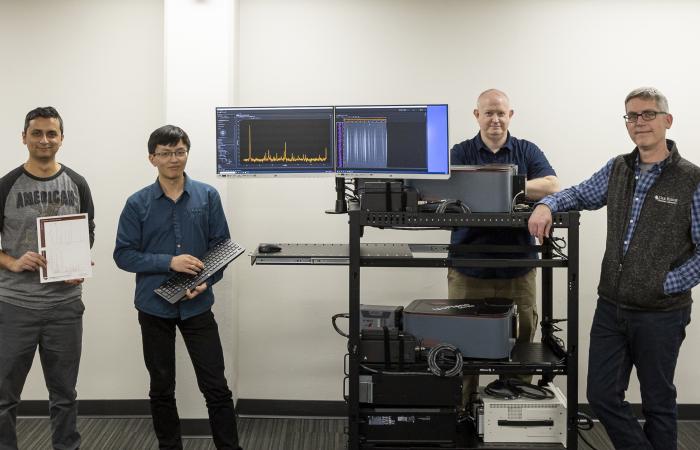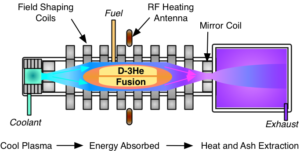Check out the ARPA-E Energy Brief featuring their Fusion Portfolio.
We discuss the Princeton Field Reversed Configuration machine. There are also great segments from other fusion researchers.
Clean, Compact Fusion
Check out the ARPA-E Energy Brief featuring their Fusion Portfolio.
We discuss the Princeton Field Reversed Configuration machine. There are also great segments from other fusion researchers.
Princeton Fusion Systems announced today that it was awarded $1.1 million in funding from the U.S. Department of Energy’s Advanced Research Projects Agency-Energy (ARPA-E). The funding will be used to develop advanced power electronics for the heating and control of fusion plasmas.
Princeton Fusion Systems received this competitive award from ARPA-E’s Galvanizing Advances in Market-aligned fusion for an Overabundance of Watts (GAMOW) program, working to close multiple fusion-specific technological gaps that will be needed to connect a net-energy-gain “fusion core,” once it is ready, to a deployable, commercially attractive fusion system. Princeton Fusion Systems joins 13 other teams in the $29M GAMOW program.
The team consists of Princeton Fusion Systems, Princeton University, the National Renewable Energy Laboratory and United Silicon Carbide. Over the 30 month duration of the contract, the team will develop efficient, high-power electrical drivers for plasma heating, compression, and control. Wide-bandgap (WBG) semiconductor devices and innovative amplifiers may speed up the development of fusion systems and reduce their eventual cost of electricity. Princeton Fusion Systems will develop prototype, high efficiency switching amplifiers using WBG SiC devices and amplifier boards that employ advanced cooling and digital control. The project will design, test, and qualify individual circuit boards as the building blocks for various short-pulse, long-pulse, and continuous-wave electrical-driver power supplies for fusion-energy systems.
Our team is mentioned in this press release from ORNL about the “traveling” high-temperature plasma diagnostic they are building:
https://www.ornl.gov/news/ornl-team-builds-portable-diagnostic-fusion-experiments-shelf-items

ARPA-E is supporting the development of several such portable diagnostics in tandem with their other fusion efforts, including our OPEN project. The ORNL team hopes that their “suitcase Thomson scattering” diagnostic will be on its way to us this summer!
When installed, it will measure the electron temperature and density profiles in the PFRC-2 experiment as a function of radius, as often as once per millisecond. The profiles measured will allow us to probe the internal structure of the plasma, but beyond that will also allow us to better interpret the results of our other diagnostics!
Princeton Propeller is a series of talks supported by the Princeton Area Alumni Association (PA3) to showcase technical innovation. Our team was recently invited to give a talk on the new frontier of commercial fusion development! Dr. Swanson and Ms. Thomas took the podium on February 11, 2020, at the Quadrangle Club on Princeton’s campus.
Download our slides at this link:
“Frontiers in Commercializing Fusion Development” Slides

We are now joined by over a dozen private companies in the UK and the US pursuing commercial fusion development. Recent programs in the Department of Energy and their ARPA-E advanced projects division have supported teams in magneto-inertial confinement (ALPHA), compact tokamaks, pinches, and our PFRC (OPEN), and public-private partnerships between labs and the private companies (INFUSE). It’s a great time to be in fusion research!
We have released a new video about the PFRC which highlights terrestrial applications of a fusion microreactor! Enjoy!
We have been hard at work on our ARPA-E project and just submitted our second quarterly report! Our team, including our summer interns, presented several posters on the latest PFRC-2 experimental results at the APS Division of Plasma Physics meeting, held Oct. 21-25 in Ft. Lauderdale, FL.
We noticed this past Sunday that even Scott Adams has taken notice of fusion companies being in the news:

This is very timely since our ARPA-E OPEN grant was just awarded this week! We are definitely working on it!
Princeton Fusion Systems has been awarded $1.25 Million from ARPA-E for Low-Radioactivity Compact Fusion Devices
Today ARPA-E announced announced that PFS has received a competitive $1.25 million award from the U.S. Department of Energy’s Advanced Research Projects Agency-Energy (ARPA-E), as part of the Energy cohort of OPEN 2018.
Princeton Fusion Systems seeks to develop technologies to enable future commercial fusion power. Our team’s concept is a small, clean, and portable design based on a field-reversed-configuration plasma. The concept uses an innovative method called odd-parity rotating magnetic field (RMF) to drive electrical current and heat the plasma to fusion temperatures. Under this award, the team will pursue improved electron and ion temperatures through RMF, as well as identify the modeling needed to elucidate the key heating and loss mechanisms for the fusion reactor concept. The team’s ultimate power plant design seeks a very small footprint for a compact, potentially transportable, distributed energy resource that is fully dispatchable and emissions-free.
PFS received this competitive award from ARPA-E’s OPEN 2018 program, in which teams develop innovative technologies to transform the nation’s energy system. OPEN solicitations are an open call to scientists and engineers for technologies across the entire scope of ARPA-E’s energy mission.
Princeton Fusion Systems is developing a new class of small fusion reactors. The terrestrial reactor is the PFRC, or Princeton Field-Reversed Configuration; configured as a fusion rocket it is known as Direct Fusion Drive (DFD).
